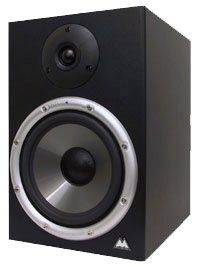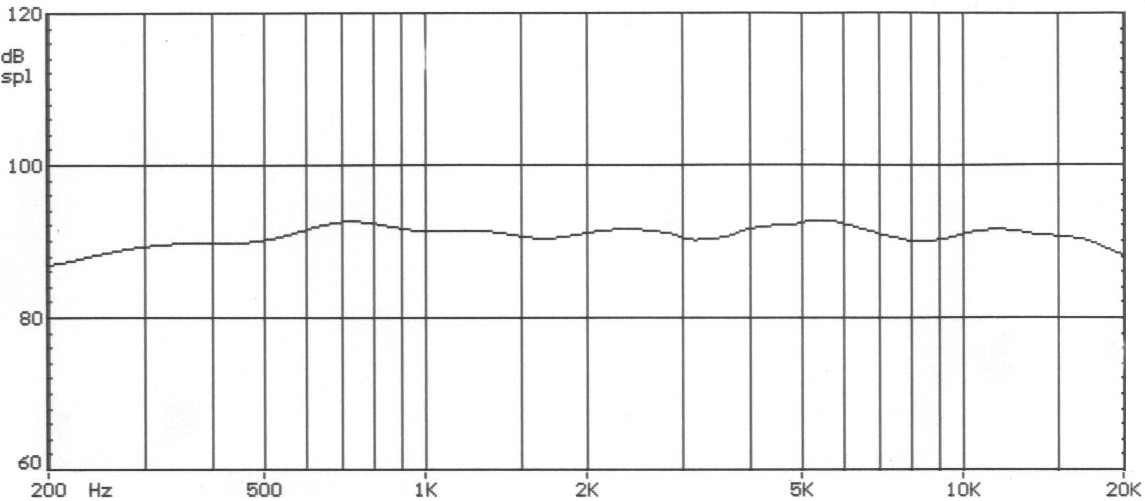Nearfield monitors for the recordist on a budget
. . . .
 |
| M-Audio SP-8B Studiophile |
Overview
Almost a year ago, M-Audio released its first monitor, the SP-5B Studiophile,
into an overly saturated market of cheap, bookshelf-sized nearfield
monitors. Given the market for which that the SP-5B was designed, it
came as no surprise that it received rather mixed feelings among serious
users. However, presumably to appease the audience which found the smaller
counterpart inadequate, the company later unveiled a full-sized budget
nearfield monitor, the SP-8B, the monitor which is the focus of this
review. Based from the size and price differences between the two systems,
it is obvious that M-Audio succeeded in making the SP-8B exceed the
quality of the SP-5B in almost every way, which may alleviate the concerns
of those turned off by the SP-5B, but it still may be in question whether
the SP-8B monitoring system can compare with other, more expensive full-sized
nearfields. Let us further examine the SP-8B now, then, to ascertain
whether this monitor is worth your consideration.
The Design
Glancing at the outer design of the SP-8B gives the impression that
it has a fairly simple layout for a monitor in this class. A no-frills
14.97 x 9.5 x 11.82 in. (hwd) MDF cabinet carries a 1" natural silk
dome tweeter and 8" polypropylene woofer on the front panel. Also of
note on the front is a unique blue LED, which serves as a power indicator,
located in the metal mounting ring encircling the woofer. Looking at
the back panel reveals balanced/unbalanced 1/4" TRS and balanced XLR
inputs, a power switch, volume knob, and a 1.5" plastic bass port.
 |
| the frequency response graph of the SP-8B |
Data that M-Audio provides with each monitor reveals a fairly even
frequency response, with a response window of approximately +-3 dB,
which is respectable even compared to more expensive monitors. More
importantly, there seems to be no large anomalies around the cross-over
frequency of 1.8 kHz. However, inspecting the data more closely reveals
that the graph only extends to 200 Hz, so while the middle and upper
ranges are shown to be fairly even, the accuracy of the bass response
is still in question.
Thus far, the SP-8B appears to be a standard, albeit simplistic, full-sized
nearfield based solely on its design. However, the question that still
remains is whether this seemingly standard monitor can truly compare
with the competition, and listening is the only way to find out whether
the design specifications are meaningful or misleading.
The Sound
Placing the SP-8B in various environments and testing a wide breadth
of listening material led me to neither completely love or loathe the
monitor. I will begin with the best features of this mixed-performance
monitor.
First, the stereo separation in the SP-8B, like in the SP-5B, is absolutely
superb. The stereo field it creates is quite clear and precise, with
a definite sense of 3-D space, and thus placing parts of the mix in
the field may be done with ease, albeit the “sweet spot”
for the field should be much larger. Still, this aspect of the monitor
is still excellent, comparable to the separation offered by more expensive
monitors such as the Event 20/20s and Mackie HR824.
The detail in the upper frequency ranges is almost is good, meaning
that few subtle, treble parts will be disappear on these monitors. The
actual response of the upper ranges, which is one of the most commended
aspects of the SP-5B, is also clear and non-fatiguing on these monitors,
mostly due to the presence of a soft-dome tweeter. The manual asserts
that the frequency range extends to 22 kHz, and given my experience,
this is not unreasonable. One thing of note that this monitor has in
relation to its smaller counterpart: though slightly more defined, the
high frequencies are still not quite as sweet sounding (or inaccurate,
for that matter) as on the SP-5B system, which will come as a displeasure
for those accustomed to the SP-5B.
Specifications (as provided by M-Audio)
- Type: 2-way near field monitors
- Woofer: 8-inch driver with magnetically shielded mineral-filled
polypropylene cone, high-temperature tolerant voice coil and damped
rubber surround
- Tweeter: 1-inch swivel-mounted silk dome incorporating magnetic
shielding, ferro-fluid and internal damping technologies
- Crossovers: 4th-order Linkwitz Riley
- Input Connectors: XLR balanced, TRS balanced/ unbalanced
- Frequency Response: 33Hz - 22kHz
- Crossover Frequency: 1.8kHz
- S/N Ratio: > 100dB below full output, 20kHz bandwidth
- Low Frequency Amplifier Power: 55W
- High Frequency Amplifier Power: 45W
- Cabinet: Vinyl-laminated MDF
- Dimension: 14.97 in. (h) x 9.5 in. (w) x 11.82 in. (d)
- Weight: 20.3 lb./unit
However, the mid and lower frequencies, both in response and detail,
do not fare nearly as well. Despite what the frequency graph indicates,
the middle frequencies still seem overly prominent, meaning that vocals
especially sound harsh instead of crisp. Fortunately, the dominance
of the midrange does not create an extremely boxy effect as on most
monitors with the same exaggerated response. The detail in this range,
furthermore, is quite muddy, and, thus, it seems to take a great amount
of time to tweak sound settings in the midrange effectively. The bass
frequencies, however, are portrayed even worse, and, in fact, are the
weakest point of this monitor. Though the manual suggests that frequencies
as low as 33 Hz are present, I only find the useable, reasonably flat
response extending to about 50-60 Hz. Beyond that, the bass degrades
to undefined, attenuated thumps that are quite like those on cheap consumer
subwoofers. The fact that the bass ports are on the rear panel, meaning
that extremely low frequencies are diverted from the listener, certainly
does not improve the quality of the bass. Yes, the SP-8B has a far superior
bass end to them than bookshelf-sized monitors in the SP-8B’s
price range, but it is still lackluster in comparison to most monitors
of its size. Another shortcoming of the SP-8B is a complete lack of
EQ adjusting options.
Due to the forward character and inadequate bass in this monitor, I
surmise that many people would want to tweak the response in some mixing
situations to give a more accurate sound, but, unfortunately, the monitor
has no EQ adjustment knobs. Obviously M-Audio wanted to keep the price
as low as possible, but the monitor suffers dearly as a result of the
absence of this feature. A more successful way the company cuts cost
without sacrificing quality: keeping the cabinet strictly functional
and not ornate.
Conclusion
Overall, this monitoring system is worth testing. It certainly has
compromises in order to trim the price tag, but it performs reasonably
well given the price difference between this and most full-sized nearfield
systems (most cost more than $1,000, as compared to about $500 street
price for the SP-8B). If anything, the SP-8B should serve as a reasonably
good set of monitors that can be used to A/B the treble and stereo field
details in a mix originally articulated on a better set of monitors,
presumably a set to which you will upgrade after you have outgrown these.
Write a comment below. No registration needed!
